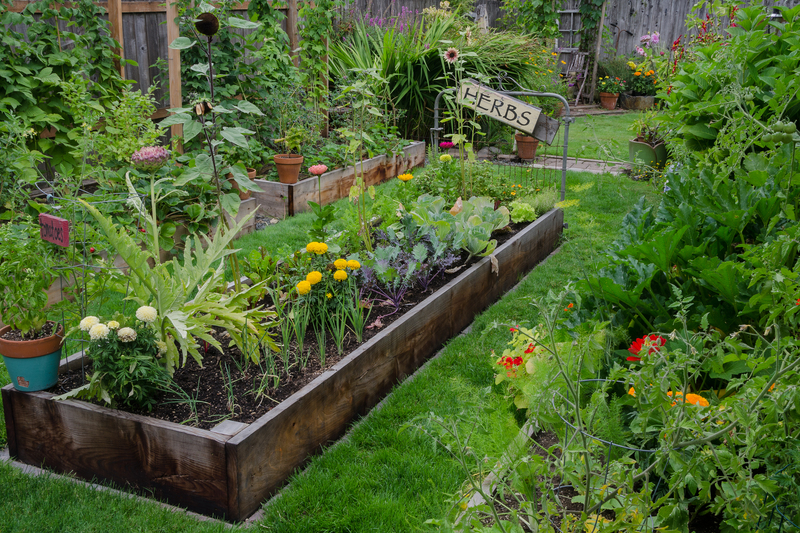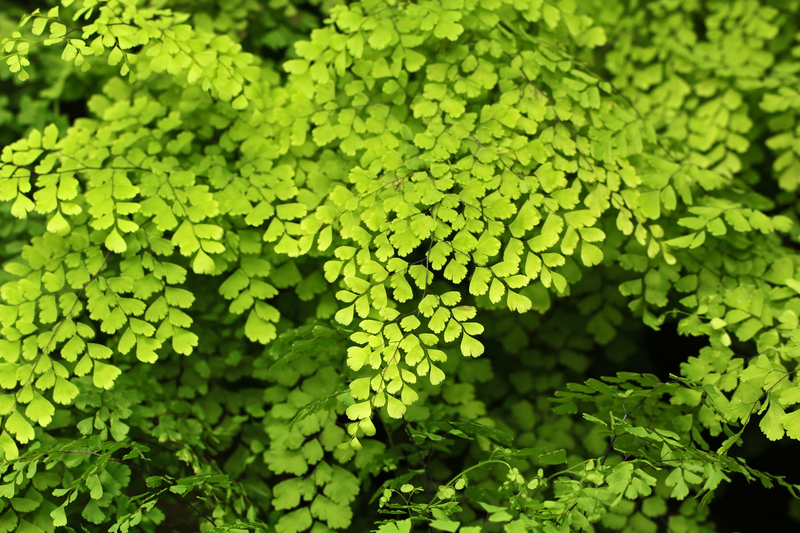Essential Tips for Cultivating a Healthy Herb Oasis
Posted on 18/08/2025
Essential Tips for Cultivating a Healthy Herb Oasis
Are you dreaming of transforming a small patch of your backyard, kitchen windowsill, or even a balcony into a lush and vibrant herb garden? Growing your own herbs is not only rewarding and therapeutic, but it also delivers fresh flavors straight to your kitchen. Whether you're a beginner or a seasoned green thumb, understanding the key principles is crucial for cultivating a thriving herb oasis. In this comprehensive guide, we'll delve deep into practical, actionable tips for building and maintaining a healthy herb sanctuary. Let's create that aromatic paradise you've always wanted!

Why Cultivate Your Own Herb Oasis?
Before we dig into the soil--literally and figuratively--let's explore why growing fresh herbs at home is both essential and satisfying:
- Unmatched freshness: Home-grown herbs offer flavors and aromas that dried or store-bought varieties simply can't match.
- Cost-effective: A few packets of seeds yield an abundance of herbs compared to weekly supermarket purchases.
- Therapeutic value: Gardening is a soothing activity that reduces stress and fosters mindfulness.
- Eco-friendly: Growing your own herbs reduces packaging waste and carbon footprint.
- Personalization: You get to choose the exact varieties and flavors you love most.
From gourmet meals to healing teas, a vibrant herb oasis empowers your culinary and wellness endeavors!
Step-by-Step Guide for a Flourishing Herb Garden
1. Choose the Right Location for Your Herb Haven
The foundation of a successful herb garden is choosing the right spot. Most culinary herbs, such as basil, rosemary, oregano, sage, and thyme, require at least 6-8 hours of sunlight per day.
- Windowsills: South-facing windows receive the most sunlight.
- Balconies: Ensure enough direct light, and consider movable planter boxes for best light exposure.
- Backyards: Raised beds or designated herb patches prevent overcrowding and soil compaction.
Gardeners with limited sunlight can opt for grow lights--modern LED setups are energy-efficient and perfect for growing herbs indoors throughout the year.
2. Select Suitable Herbs for Your Space and Needs
Are you looking for kitchen staples like parsley and cilantro, or do you prefer medicinal plants such as chamomile and lemon balm? The key is to start small and pick varieties suited to your growing conditions. Some beginner-friendly options include:
- Basil: Thrives in sunny, warm spots and is perfect for Italian dishes.
- Mint: Hardy and fast-spreading; best grown in containers to prevent it from taking over your garden.
- Chives: Perennial and easy to maintain, chives add a mild onion flavor to many recipes.
- Thyme and Oregano: Both are drought-resistant and essential for Mediterranean cuisine.
- Rosemary: Needs well-drained soil and loves the sun; its aromatic sprigs are great for roasts.
_Pro tip:_ Combine herbs with similar sunlight and water needs in the same container or garden bed for easier maintenance.
3. Prepare Nutrient-Rich Soil for Your Herb Oasis
Soil quality is a crucial aspect of a flourishing herb garden. Most herbs do well in well-drained, loamy soil with moderate fertility. Here's how to optimize your soil:
- pH Balance: Aim for a pH of 6.0 to 7.5 for most herbs.
- Organic Matter: Work in aged compost or worm castings to improve structure and nutrition.
- Drainage: If you're container gardening, use pots with drainage holes and a loose, aerated potting mix.
Mixing sand or perlite can enhance drainage for Mediterranean herbs like rosemary, sage, and thyme.
4. Smart Planting Techniques for Herb Gardens
Successful herb cultivation hinges on how you start your plants. Here's what you need to know:
- Seeds vs. Seedlings: Some herbs, such as basil, grow easily from seed; others like rosemary and lavender are simpler to start from small plants.
- Spacing: Give each herb enough room to expand. Crowded plants may compete for nutrients and sunlight, stunting growth.
- Timing: Annuals like basil and dill are best sown in spring, while perennials like thyme or chives can be planted in early spring or fall in mild climates.
_Always follow the instructions on your seed packet or plant label for best results._
5. Mastering Watering Techniques for Optimal Herb Health
The right watering routine is vital for a healthy herb garden oasis. Overwatering leads to root rot, while underwatering stresses your plants. Consider these key points:
- Allow the top inch of soil to dry before the next watering.
- Morning watering helps prevent fungal diseases and ensures herbs get enough moisture during the day.
- Group herbs by water needs: Mediterranean herbs (thyme, oregano) prefer less frequent deep waterings, whereas basil appreciates more consistent moisture.
- Mulch around your plants to help retain moisture and regulate soil temperature.
6. Fertilization Tips for a Lush Herb Sanctuary
Herbs generally require far less fertilizer than other garden plants. Too much fertilizer, especially nitrogen, can result in leafy growth with reduced flavor.
- Use organic fertilizers like compost or seaweed extract for gentle feeding.
- Feed every 4-6 weeks during the growing season; avoid late-season fertilizers for perennial herbs.
- Container gardens may need more frequent, diluted feedings due to leaching from frequent watering.
Remember: More is not always better; restrained feeding results in more aromatic herbs.
7. Pruning and Harvesting: Promote Growth and Prevent Disease
Regularly harvesting your herbs not only gives you a fresh supply but also encourages bushy growth and helps prevent disease.
- Pinch Early: For annuals like basil, pinch off the top sets of leaves to foster side shoots.
- Don't Overharvest: Never remove more than one-third of the plant at a time.
- Remove Flowers: Pinch off flower buds (unless you want seeds), as flowering often reduces leaf flavor and signals the plant to stop growing.
_Tip: Use sharp scissors or pruners to minimize plant stress and reduce the risk of disease._
8. Natural Pest and Disease Control for Herb Gardens
While fresh herbs tend to be less susceptible to pests than many vegetables, they're not immune. To protect your herb oasis:
- Encourage beneficial insects like ladybugs and lacewings by planting companion flowers.
- Use neem oil or insecticidal soap sprays to manage aphids, spider mites, or whiteflies.
- Regularly inspect for fungal issues like powdery mildew--watering at the base, not overhead, can help.
- Plant strong-smelling herbs such as chives and garlic near susceptible varieties to ward off pests naturally.
9. Smart Container Gardening for Herb Lovers
For gardeners short on space, container gardening is a fantastic way to create a portable, flexible herb oasis. Key factors to consider:
- Container Size: Most herbs thrive in 6-12 inch pots; larger containers accommodate mixed plantings.
- Drainage: Ensure good drainage to avoid root rot--a layer of pebbles at the bottom helps.
- Regular Watering: Containers dry out faster than ground beds, so watch for wilting or dry soil.
_Mixing herbs in ornamental containers creates a functional and visually appealing patio or kitchen garden._
10. Seasonal Care and Overwintering Your Herb Oasis
Properly caring for your herbs through the changing seasons ensures ongoing health and productivity:
- Spring: Refresh mulch, add light compost, and start new seedlings.
- Summer: Water deeply, deadhead flowers, and watch for pests.
- Autumn: Harvest excess herbs, dry or freeze for winter, and prune perennials lightly.
- Winter: Bring tender herbs like basil indoors or protect with frost covers; cut back on watering for dormant perennials.
_Overwintering tip: Hardy herbs such as sage, thyme, and chives can survive outdoors in most climates; tender varieties require protection._
Troubleshooting Common Herb Gardening Problems
Even experienced gardeners face challenges. Here's how to address typical issues in your herb sanctuary:
- Yellow Leaves: Usually indicates overwatering or poor drainage. Ensure your containers have holes and don't let herbs sit in water.
- Leggy Stems: Most often a result of low sunlight. Move your plants to a brighter location or supplement with grow lights.
- Slow Growth: Herbs grown in depleted soil can benefit from a light dose of organic fertilizer.
- Pest Infestations: Physically remove insects and use gentle organic sprays if necessary. Avoid broad-spectrum pesticides that harm beneficial insects.

Creative Ways to Use Fresh Herbs from Your Oasis
One of the greatest joys of a healthy herb garden oasis is incorporating vibrant flavors and aromas into everyday life. A few inspiring uses:
- Cooking: Elevate salads, pasta, soups, and sauces with fresh chopped herbs. Mix your own herb butters, oils, or infuse vinegars.
- Drinks: Muddle mint, lemon balm, or basil in cocktails, teas, and homemade lemonade.
- Aromatherapy: Create calming sachets, bath soaks, or natural air fresheners from lavender, rosemary, or mint.
- Natural Remedies: Brew teas from chamomile, lemon verbena, or sage for their soothing properties.
- Gift Ideas: Share bunches of herbs, herb-infused oils, or homemade herbal soaps with friends and family.
With a little creativity, every corner of your kitchen and home can benefit from your herb garden oasis.
Conclusion: Your Path to a Healthy Herb Haven
Cultivating a thriving herb oasis is more than a hobby--it's a journey into sustainable living, self-sufficiency, and joyful cooking. By choosing the right site, selecting herbs suited to your environment, using nutrient-rich soil, and practicing mindful care, you'll enjoy a continual harvest all season long. With the essential tips outlined above, your dream of a luscious, aromatic herb paradise is well within reach.
_Unearth the joys of gardening and elevate your daily rituals with a flourishing herb sanctuary--one aromatic sprig at a time!_

